Promoting Health in Extended Care: A Case Study of Elderly Care
VerifiedAdded on 2023/06/14
|9
|2998
|71
Essay
AI Summary
This essay provides an analysis of Amalie's scenario, an 89-year-old woman, and develops a nursing plan of care using Levett-Jones Clinical Reasoning model and Miller's nursing wellness for older adults. It identifies key nursing priorities including vision deficit, risk of falls and injuries, and altered nutritional patterns. The essay applies the Functional Consequences Theory and the Clinical Reasoning Cycle to assess Amalie's condition, set goals, implement nursing interventions, and evaluate outcomes. Specific actions include nutritional assessment, community agency referrals, and counseling, with a focus on improving Amalie's ability to perform daily activities, increase appetite, and reduce isolation. The reflection emphasizes the importance of home-based care and the applicability of the Clinical Reasoning Model in elderly care.

Running head: HEALTH CARE OF THE ELDERY 1
PROMOTING HEALTH IN EXTENED CARE
Student’s Name
University Affiliation
Course
Date
PROMOTING HEALTH IN EXTENED CARE
Student’s Name
University Affiliation
Course
Date
Paraphrase This Document
Need a fresh take? Get an instant paraphrase of this document with our AI Paraphraser
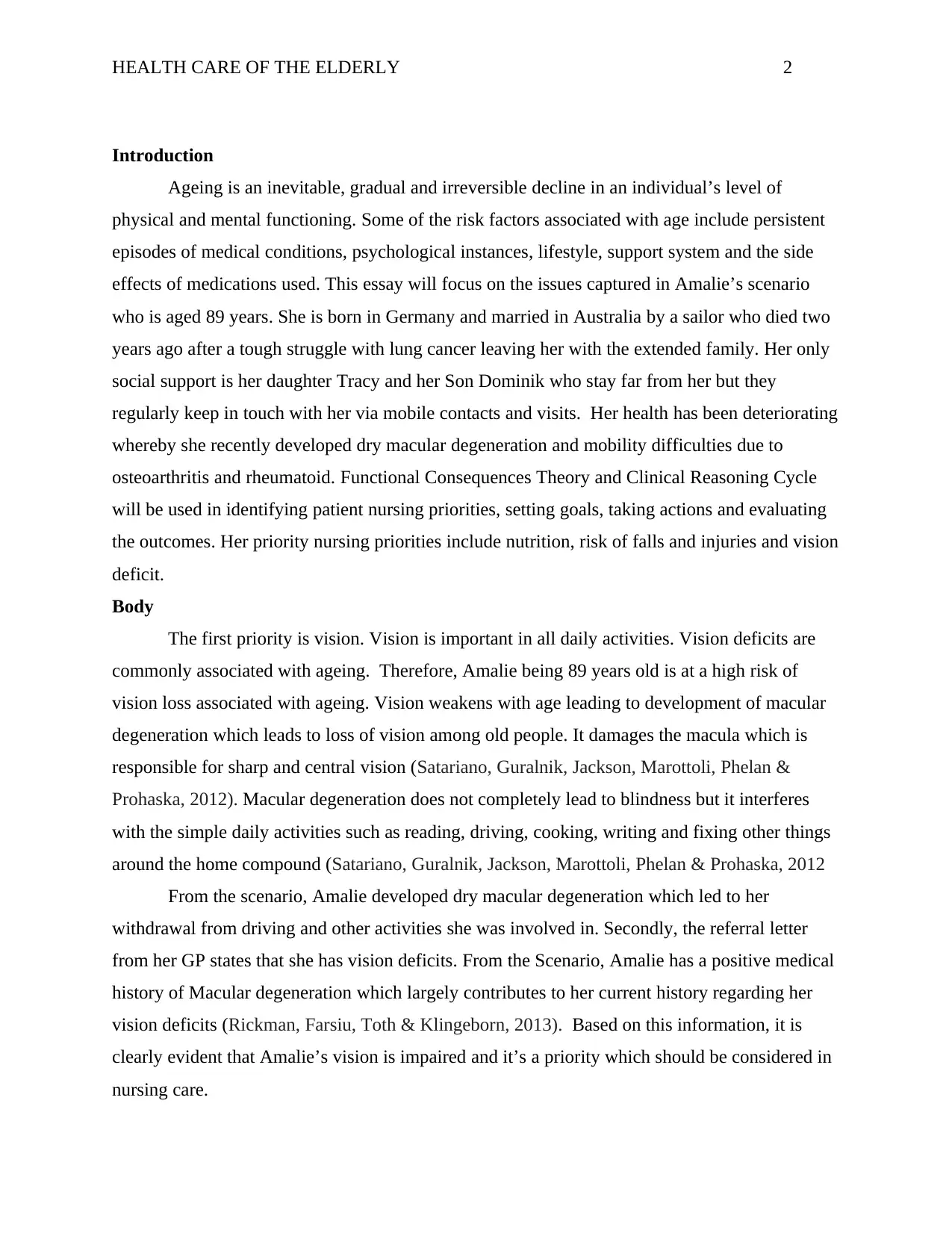
HEALTH CARE OF THE ELDERLY 2
Introduction
Ageing is an inevitable, gradual and irreversible decline in an individual’s level of
physical and mental functioning. Some of the risk factors associated with age include persistent
episodes of medical conditions, psychological instances, lifestyle, support system and the side
effects of medications used. This essay will focus on the issues captured in Amalie’s scenario
who is aged 89 years. She is born in Germany and married in Australia by a sailor who died two
years ago after a tough struggle with lung cancer leaving her with the extended family. Her only
social support is her daughter Tracy and her Son Dominik who stay far from her but they
regularly keep in touch with her via mobile contacts and visits. Her health has been deteriorating
whereby she recently developed dry macular degeneration and mobility difficulties due to
osteoarthritis and rheumatoid. Functional Consequences Theory and Clinical Reasoning Cycle
will be used in identifying patient nursing priorities, setting goals, taking actions and evaluating
the outcomes. Her priority nursing priorities include nutrition, risk of falls and injuries and vision
deficit.
Body
The first priority is vision. Vision is important in all daily activities. Vision deficits are
commonly associated with ageing. Therefore, Amalie being 89 years old is at a high risk of
vision loss associated with ageing. Vision weakens with age leading to development of macular
degeneration which leads to loss of vision among old people. It damages the macula which is
responsible for sharp and central vision (Satariano, Guralnik, Jackson, Marottoli, Phelan &
Prohaska, 2012). Macular degeneration does not completely lead to blindness but it interferes
with the simple daily activities such as reading, driving, cooking, writing and fixing other things
around the home compound (Satariano, Guralnik, Jackson, Marottoli, Phelan & Prohaska, 2012
From the scenario, Amalie developed dry macular degeneration which led to her
withdrawal from driving and other activities she was involved in. Secondly, the referral letter
from her GP states that she has vision deficits. From the Scenario, Amalie has a positive medical
history of Macular degeneration which largely contributes to her current history regarding her
vision deficits (Rickman, Farsiu, Toth & Klingeborn, 2013). Based on this information, it is
clearly evident that Amalie’s vision is impaired and it’s a priority which should be considered in
nursing care.
Introduction
Ageing is an inevitable, gradual and irreversible decline in an individual’s level of
physical and mental functioning. Some of the risk factors associated with age include persistent
episodes of medical conditions, psychological instances, lifestyle, support system and the side
effects of medications used. This essay will focus on the issues captured in Amalie’s scenario
who is aged 89 years. She is born in Germany and married in Australia by a sailor who died two
years ago after a tough struggle with lung cancer leaving her with the extended family. Her only
social support is her daughter Tracy and her Son Dominik who stay far from her but they
regularly keep in touch with her via mobile contacts and visits. Her health has been deteriorating
whereby she recently developed dry macular degeneration and mobility difficulties due to
osteoarthritis and rheumatoid. Functional Consequences Theory and Clinical Reasoning Cycle
will be used in identifying patient nursing priorities, setting goals, taking actions and evaluating
the outcomes. Her priority nursing priorities include nutrition, risk of falls and injuries and vision
deficit.
Body
The first priority is vision. Vision is important in all daily activities. Vision deficits are
commonly associated with ageing. Therefore, Amalie being 89 years old is at a high risk of
vision loss associated with ageing. Vision weakens with age leading to development of macular
degeneration which leads to loss of vision among old people. It damages the macula which is
responsible for sharp and central vision (Satariano, Guralnik, Jackson, Marottoli, Phelan &
Prohaska, 2012). Macular degeneration does not completely lead to blindness but it interferes
with the simple daily activities such as reading, driving, cooking, writing and fixing other things
around the home compound (Satariano, Guralnik, Jackson, Marottoli, Phelan & Prohaska, 2012
From the scenario, Amalie developed dry macular degeneration which led to her
withdrawal from driving and other activities she was involved in. Secondly, the referral letter
from her GP states that she has vision deficits. From the Scenario, Amalie has a positive medical
history of Macular degeneration which largely contributes to her current history regarding her
vision deficits (Rickman, Farsiu, Toth & Klingeborn, 2013). Based on this information, it is
clearly evident that Amalie’s vision is impaired and it’s a priority which should be considered in
nursing care.
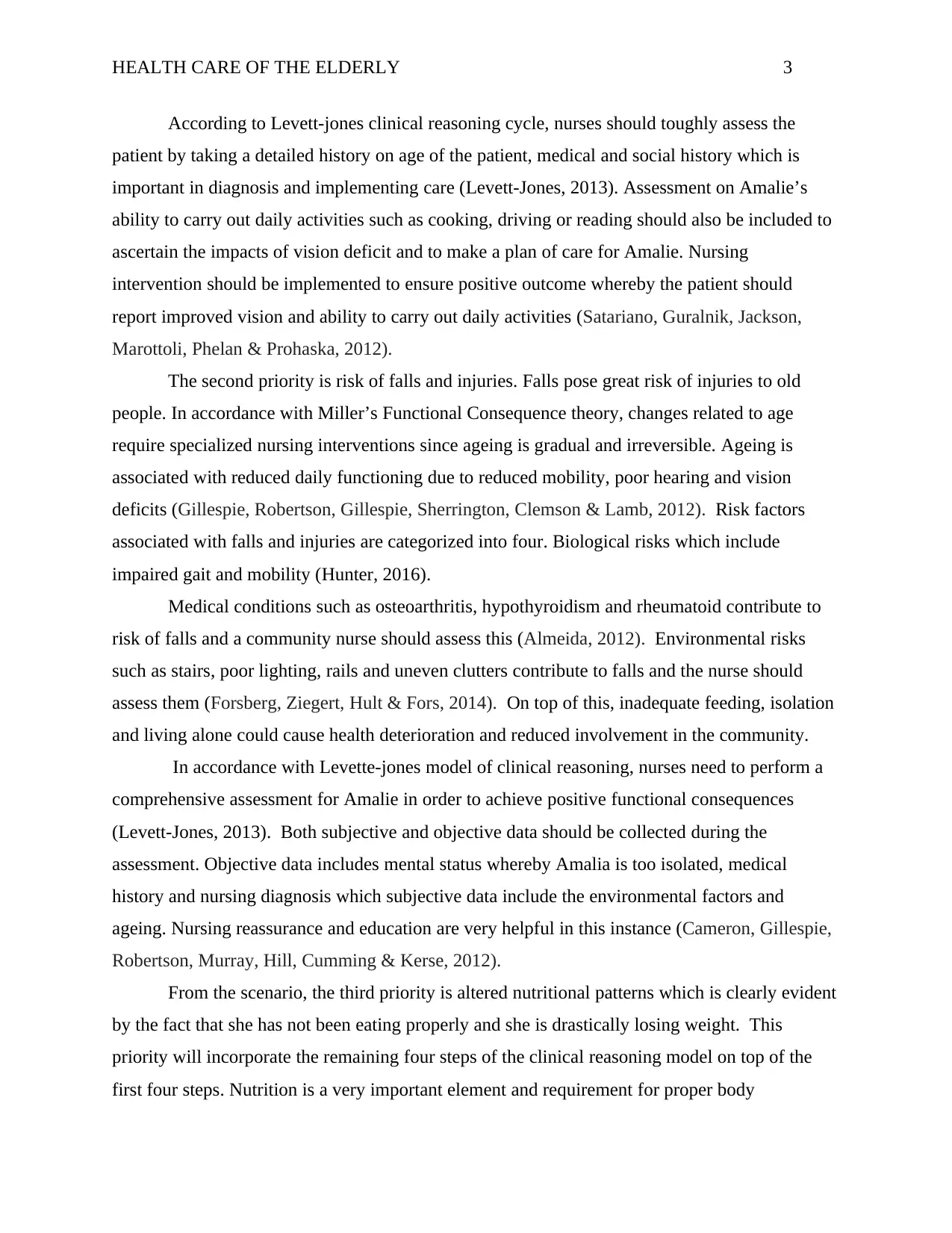
HEALTH CARE OF THE ELDERLY 3
According to Levett-jones clinical reasoning cycle, nurses should toughly assess the
patient by taking a detailed history on age of the patient, medical and social history which is
important in diagnosis and implementing care (Levett-Jones, 2013). Assessment on Amalie’s
ability to carry out daily activities such as cooking, driving or reading should also be included to
ascertain the impacts of vision deficit and to make a plan of care for Amalie. Nursing
intervention should be implemented to ensure positive outcome whereby the patient should
report improved vision and ability to carry out daily activities (Satariano, Guralnik, Jackson,
Marottoli, Phelan & Prohaska, 2012).
The second priority is risk of falls and injuries. Falls pose great risk of injuries to old
people. In accordance with Miller’s Functional Consequence theory, changes related to age
require specialized nursing interventions since ageing is gradual and irreversible. Ageing is
associated with reduced daily functioning due to reduced mobility, poor hearing and vision
deficits (Gillespie, Robertson, Gillespie, Sherrington, Clemson & Lamb, 2012). Risk factors
associated with falls and injuries are categorized into four. Biological risks which include
impaired gait and mobility (Hunter, 2016).
Medical conditions such as osteoarthritis, hypothyroidism and rheumatoid contribute to
risk of falls and a community nurse should assess this (Almeida, 2012). Environmental risks
such as stairs, poor lighting, rails and uneven clutters contribute to falls and the nurse should
assess them (Forsberg, Ziegert, Hult & Fors, 2014). On top of this, inadequate feeding, isolation
and living alone could cause health deterioration and reduced involvement in the community.
In accordance with Levette-jones model of clinical reasoning, nurses need to perform a
comprehensive assessment for Amalie in order to achieve positive functional consequences
(Levett-Jones, 2013). Both subjective and objective data should be collected during the
assessment. Objective data includes mental status whereby Amalia is too isolated, medical
history and nursing diagnosis which subjective data include the environmental factors and
ageing. Nursing reassurance and education are very helpful in this instance (Cameron, Gillespie,
Robertson, Murray, Hill, Cumming & Kerse, 2012).
From the scenario, the third priority is altered nutritional patterns which is clearly evident
by the fact that she has not been eating properly and she is drastically losing weight. This
priority will incorporate the remaining four steps of the clinical reasoning model on top of the
first four steps. Nutrition is a very important element and requirement for proper body
According to Levett-jones clinical reasoning cycle, nurses should toughly assess the
patient by taking a detailed history on age of the patient, medical and social history which is
important in diagnosis and implementing care (Levett-Jones, 2013). Assessment on Amalie’s
ability to carry out daily activities such as cooking, driving or reading should also be included to
ascertain the impacts of vision deficit and to make a plan of care for Amalie. Nursing
intervention should be implemented to ensure positive outcome whereby the patient should
report improved vision and ability to carry out daily activities (Satariano, Guralnik, Jackson,
Marottoli, Phelan & Prohaska, 2012).
The second priority is risk of falls and injuries. Falls pose great risk of injuries to old
people. In accordance with Miller’s Functional Consequence theory, changes related to age
require specialized nursing interventions since ageing is gradual and irreversible. Ageing is
associated with reduced daily functioning due to reduced mobility, poor hearing and vision
deficits (Gillespie, Robertson, Gillespie, Sherrington, Clemson & Lamb, 2012). Risk factors
associated with falls and injuries are categorized into four. Biological risks which include
impaired gait and mobility (Hunter, 2016).
Medical conditions such as osteoarthritis, hypothyroidism and rheumatoid contribute to
risk of falls and a community nurse should assess this (Almeida, 2012). Environmental risks
such as stairs, poor lighting, rails and uneven clutters contribute to falls and the nurse should
assess them (Forsberg, Ziegert, Hult & Fors, 2014). On top of this, inadequate feeding, isolation
and living alone could cause health deterioration and reduced involvement in the community.
In accordance with Levette-jones model of clinical reasoning, nurses need to perform a
comprehensive assessment for Amalie in order to achieve positive functional consequences
(Levett-Jones, 2013). Both subjective and objective data should be collected during the
assessment. Objective data includes mental status whereby Amalia is too isolated, medical
history and nursing diagnosis which subjective data include the environmental factors and
ageing. Nursing reassurance and education are very helpful in this instance (Cameron, Gillespie,
Robertson, Murray, Hill, Cumming & Kerse, 2012).
From the scenario, the third priority is altered nutritional patterns which is clearly evident
by the fact that she has not been eating properly and she is drastically losing weight. This
priority will incorporate the remaining four steps of the clinical reasoning model on top of the
first four steps. Nutrition is a very important element and requirement for proper body
⊘ This is a preview!⊘
Do you want full access?
Subscribe today to unlock all pages.

Trusted by 1+ million students worldwide
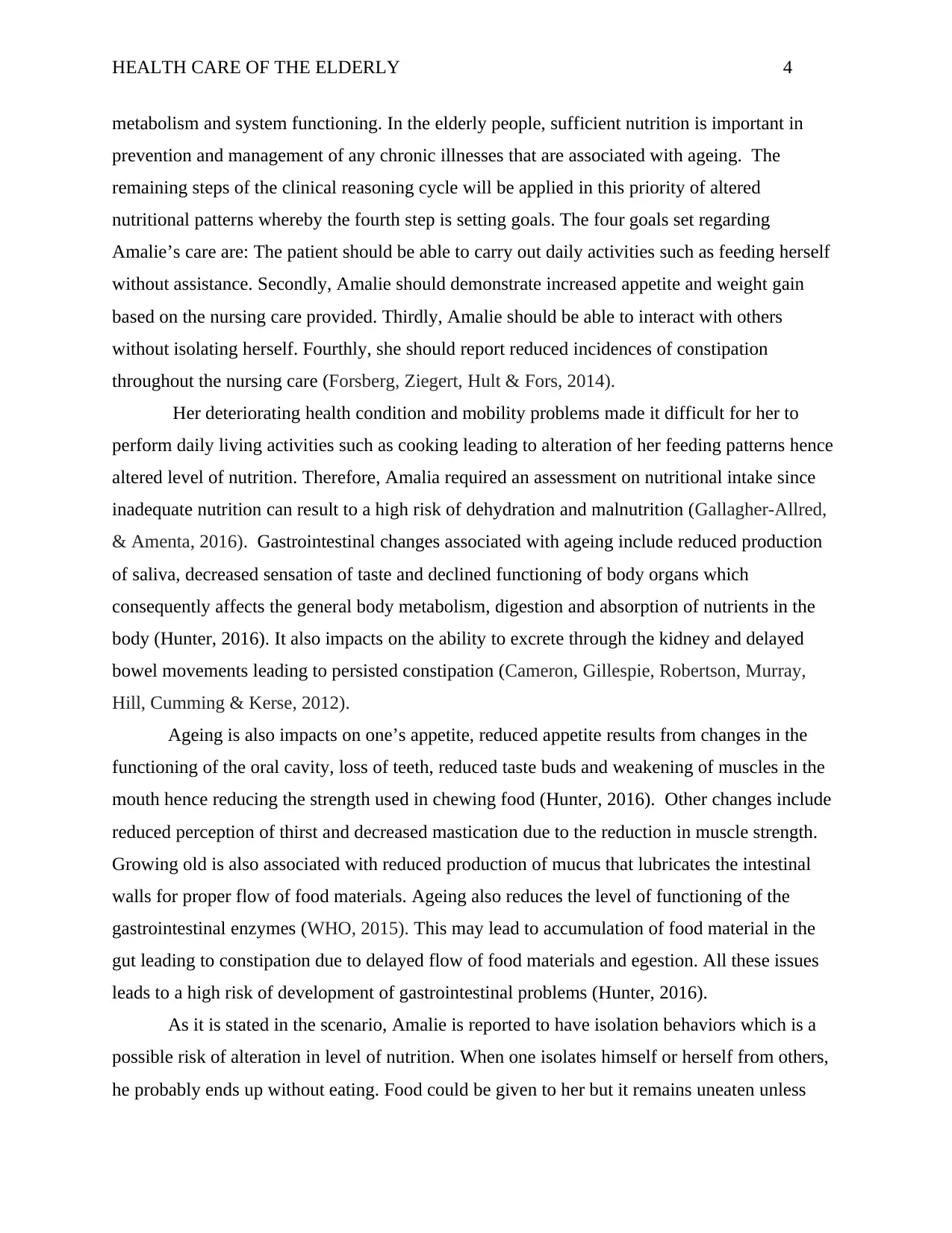
HEALTH CARE OF THE ELDERLY 4
metabolism and system functioning. In the elderly people, sufficient nutrition is important in
prevention and management of any chronic illnesses that are associated with ageing. The
remaining steps of the clinical reasoning cycle will be applied in this priority of altered
nutritional patterns whereby the fourth step is setting goals. The four goals set regarding
Amalie’s care are: The patient should be able to carry out daily activities such as feeding herself
without assistance. Secondly, Amalie should demonstrate increased appetite and weight gain
based on the nursing care provided. Thirdly, Amalie should be able to interact with others
without isolating herself. Fourthly, she should report reduced incidences of constipation
throughout the nursing care (Forsberg, Ziegert, Hult & Fors, 2014).
Her deteriorating health condition and mobility problems made it difficult for her to
perform daily living activities such as cooking leading to alteration of her feeding patterns hence
altered level of nutrition. Therefore, Amalia required an assessment on nutritional intake since
inadequate nutrition can result to a high risk of dehydration and malnutrition (Gallagher-Allred,
& Amenta, 2016). Gastrointestinal changes associated with ageing include reduced production
of saliva, decreased sensation of taste and declined functioning of body organs which
consequently affects the general body metabolism, digestion and absorption of nutrients in the
body (Hunter, 2016). It also impacts on the ability to excrete through the kidney and delayed
bowel movements leading to persisted constipation (Cameron, Gillespie, Robertson, Murray,
Hill, Cumming & Kerse, 2012).
Ageing is also impacts on one’s appetite, reduced appetite results from changes in the
functioning of the oral cavity, loss of teeth, reduced taste buds and weakening of muscles in the
mouth hence reducing the strength used in chewing food (Hunter, 2016). Other changes include
reduced perception of thirst and decreased mastication due to the reduction in muscle strength.
Growing old is also associated with reduced production of mucus that lubricates the intestinal
walls for proper flow of food materials. Ageing also reduces the level of functioning of the
gastrointestinal enzymes (WHO, 2015). This may lead to accumulation of food material in the
gut leading to constipation due to delayed flow of food materials and egestion. All these issues
leads to a high risk of development of gastrointestinal problems (Hunter, 2016).
As it is stated in the scenario, Amalie is reported to have isolation behaviors which is a
possible risk of alteration in level of nutrition. When one isolates himself or herself from others,
he probably ends up without eating. Food could be given to her but it remains uneaten unless
metabolism and system functioning. In the elderly people, sufficient nutrition is important in
prevention and management of any chronic illnesses that are associated with ageing. The
remaining steps of the clinical reasoning cycle will be applied in this priority of altered
nutritional patterns whereby the fourth step is setting goals. The four goals set regarding
Amalie’s care are: The patient should be able to carry out daily activities such as feeding herself
without assistance. Secondly, Amalie should demonstrate increased appetite and weight gain
based on the nursing care provided. Thirdly, Amalie should be able to interact with others
without isolating herself. Fourthly, she should report reduced incidences of constipation
throughout the nursing care (Forsberg, Ziegert, Hult & Fors, 2014).
Her deteriorating health condition and mobility problems made it difficult for her to
perform daily living activities such as cooking leading to alteration of her feeding patterns hence
altered level of nutrition. Therefore, Amalia required an assessment on nutritional intake since
inadequate nutrition can result to a high risk of dehydration and malnutrition (Gallagher-Allred,
& Amenta, 2016). Gastrointestinal changes associated with ageing include reduced production
of saliva, decreased sensation of taste and declined functioning of body organs which
consequently affects the general body metabolism, digestion and absorption of nutrients in the
body (Hunter, 2016). It also impacts on the ability to excrete through the kidney and delayed
bowel movements leading to persisted constipation (Cameron, Gillespie, Robertson, Murray,
Hill, Cumming & Kerse, 2012).
Ageing is also impacts on one’s appetite, reduced appetite results from changes in the
functioning of the oral cavity, loss of teeth, reduced taste buds and weakening of muscles in the
mouth hence reducing the strength used in chewing food (Hunter, 2016). Other changes include
reduced perception of thirst and decreased mastication due to the reduction in muscle strength.
Growing old is also associated with reduced production of mucus that lubricates the intestinal
walls for proper flow of food materials. Ageing also reduces the level of functioning of the
gastrointestinal enzymes (WHO, 2015). This may lead to accumulation of food material in the
gut leading to constipation due to delayed flow of food materials and egestion. All these issues
leads to a high risk of development of gastrointestinal problems (Hunter, 2016).
As it is stated in the scenario, Amalie is reported to have isolation behaviors which is a
possible risk of alteration in level of nutrition. When one isolates himself or herself from others,
he probably ends up without eating. Food could be given to her but it remains uneaten unless
Paraphrase This Document
Need a fresh take? Get an instant paraphrase of this document with our AI Paraphraser
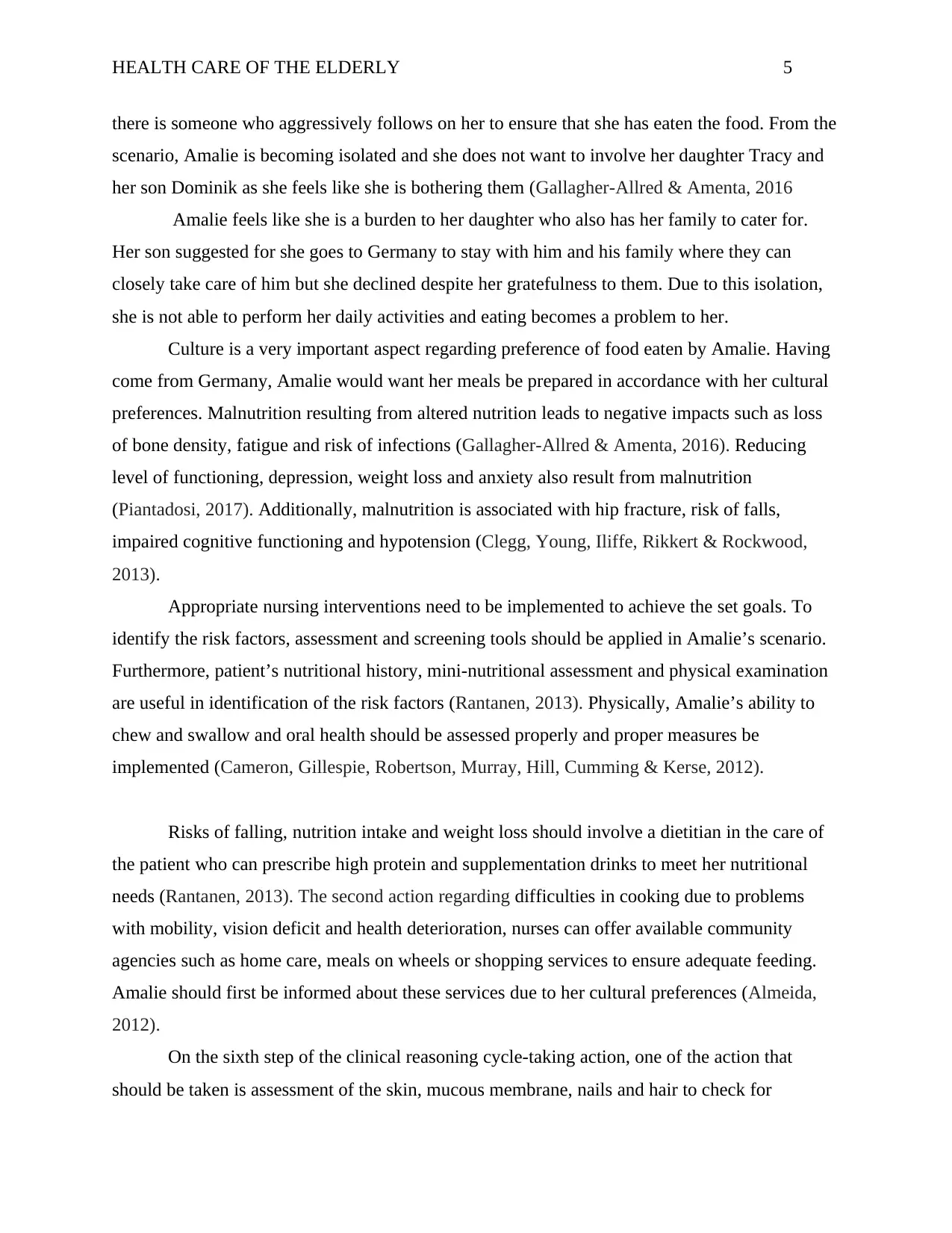
HEALTH CARE OF THE ELDERLY 5
there is someone who aggressively follows on her to ensure that she has eaten the food. From the
scenario, Amalie is becoming isolated and she does not want to involve her daughter Tracy and
her son Dominik as she feels like she is bothering them (Gallagher-Allred & Amenta, 2016
Amalie feels like she is a burden to her daughter who also has her family to cater for.
Her son suggested for she goes to Germany to stay with him and his family where they can
closely take care of him but she declined despite her gratefulness to them. Due to this isolation,
she is not able to perform her daily activities and eating becomes a problem to her.
Culture is a very important aspect regarding preference of food eaten by Amalie. Having
come from Germany, Amalie would want her meals be prepared in accordance with her cultural
preferences. Malnutrition resulting from altered nutrition leads to negative impacts such as loss
of bone density, fatigue and risk of infections (Gallagher-Allred & Amenta, 2016). Reducing
level of functioning, depression, weight loss and anxiety also result from malnutrition
(Piantadosi, 2017). Additionally, malnutrition is associated with hip fracture, risk of falls,
impaired cognitive functioning and hypotension (Clegg, Young, Iliffe, Rikkert & Rockwood,
2013).
Appropriate nursing interventions need to be implemented to achieve the set goals. To
identify the risk factors, assessment and screening tools should be applied in Amalie’s scenario.
Furthermore, patient’s nutritional history, mini-nutritional assessment and physical examination
are useful in identification of the risk factors (Rantanen, 2013). Physically, Amalie’s ability to
chew and swallow and oral health should be assessed properly and proper measures be
implemented (Cameron, Gillespie, Robertson, Murray, Hill, Cumming & Kerse, 2012).
Risks of falling, nutrition intake and weight loss should involve a dietitian in the care of
the patient who can prescribe high protein and supplementation drinks to meet her nutritional
needs (Rantanen, 2013). The second action regarding difficulties in cooking due to problems
with mobility, vision deficit and health deterioration, nurses can offer available community
agencies such as home care, meals on wheels or shopping services to ensure adequate feeding.
Amalie should first be informed about these services due to her cultural preferences (Almeida,
2012).
On the sixth step of the clinical reasoning cycle-taking action, one of the action that
should be taken is assessment of the skin, mucous membrane, nails and hair to check for
there is someone who aggressively follows on her to ensure that she has eaten the food. From the
scenario, Amalie is becoming isolated and she does not want to involve her daughter Tracy and
her son Dominik as she feels like she is bothering them (Gallagher-Allred & Amenta, 2016
Amalie feels like she is a burden to her daughter who also has her family to cater for.
Her son suggested for she goes to Germany to stay with him and his family where they can
closely take care of him but she declined despite her gratefulness to them. Due to this isolation,
she is not able to perform her daily activities and eating becomes a problem to her.
Culture is a very important aspect regarding preference of food eaten by Amalie. Having
come from Germany, Amalie would want her meals be prepared in accordance with her cultural
preferences. Malnutrition resulting from altered nutrition leads to negative impacts such as loss
of bone density, fatigue and risk of infections (Gallagher-Allred & Amenta, 2016). Reducing
level of functioning, depression, weight loss and anxiety also result from malnutrition
(Piantadosi, 2017). Additionally, malnutrition is associated with hip fracture, risk of falls,
impaired cognitive functioning and hypotension (Clegg, Young, Iliffe, Rikkert & Rockwood,
2013).
Appropriate nursing interventions need to be implemented to achieve the set goals. To
identify the risk factors, assessment and screening tools should be applied in Amalie’s scenario.
Furthermore, patient’s nutritional history, mini-nutritional assessment and physical examination
are useful in identification of the risk factors (Rantanen, 2013). Physically, Amalie’s ability to
chew and swallow and oral health should be assessed properly and proper measures be
implemented (Cameron, Gillespie, Robertson, Murray, Hill, Cumming & Kerse, 2012).
Risks of falling, nutrition intake and weight loss should involve a dietitian in the care of
the patient who can prescribe high protein and supplementation drinks to meet her nutritional
needs (Rantanen, 2013). The second action regarding difficulties in cooking due to problems
with mobility, vision deficit and health deterioration, nurses can offer available community
agencies such as home care, meals on wheels or shopping services to ensure adequate feeding.
Amalie should first be informed about these services due to her cultural preferences (Almeida,
2012).
On the sixth step of the clinical reasoning cycle-taking action, one of the action that
should be taken is assessment of the skin, mucous membrane, nails and hair to check for
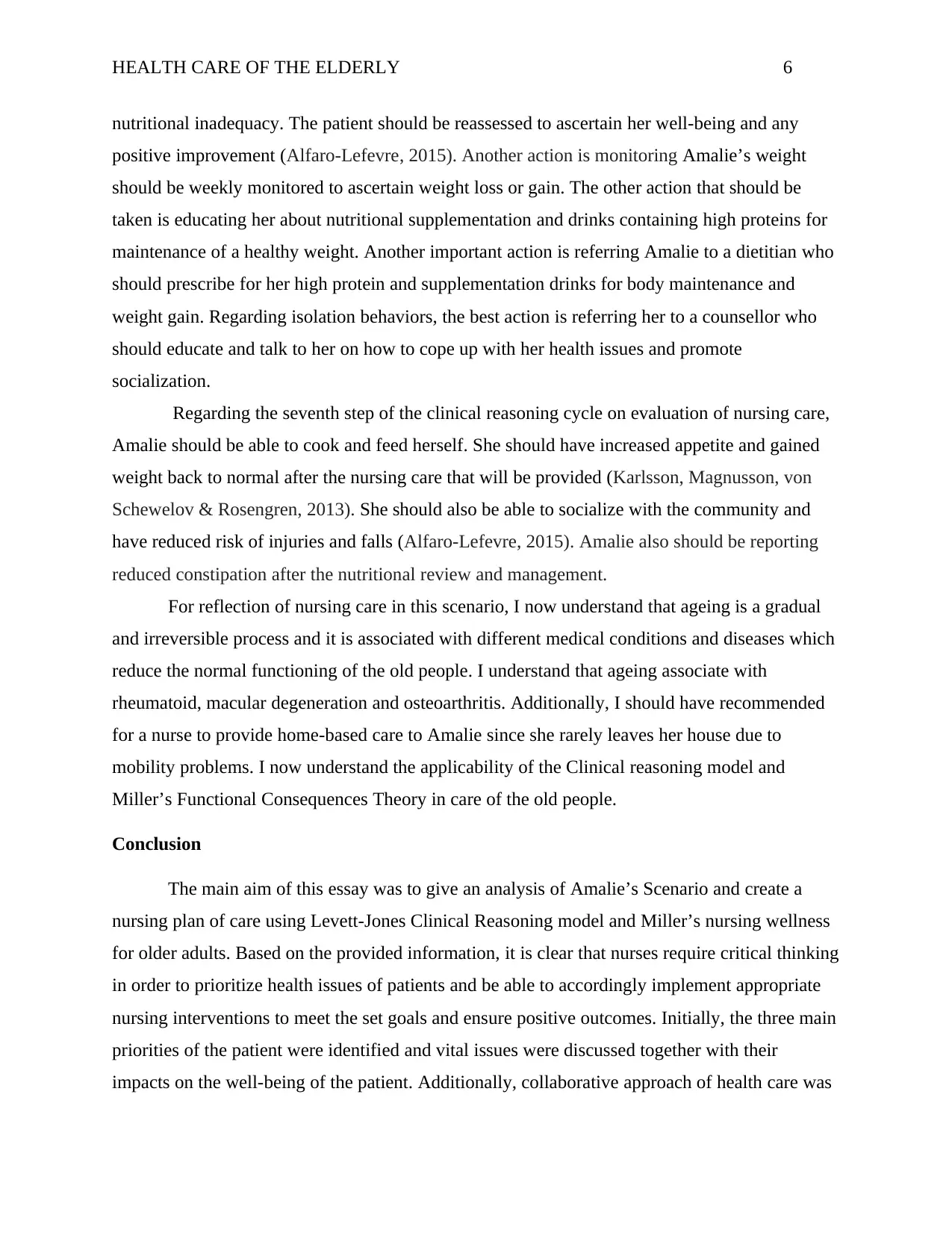
HEALTH CARE OF THE ELDERLY 6
nutritional inadequacy. The patient should be reassessed to ascertain her well-being and any
positive improvement (Alfaro-Lefevre, 2015). Another action is monitoring Amalie’s weight
should be weekly monitored to ascertain weight loss or gain. The other action that should be
taken is educating her about nutritional supplementation and drinks containing high proteins for
maintenance of a healthy weight. Another important action is referring Amalie to a dietitian who
should prescribe for her high protein and supplementation drinks for body maintenance and
weight gain. Regarding isolation behaviors, the best action is referring her to a counsellor who
should educate and talk to her on how to cope up with her health issues and promote
socialization.
Regarding the seventh step of the clinical reasoning cycle on evaluation of nursing care,
Amalie should be able to cook and feed herself. She should have increased appetite and gained
weight back to normal after the nursing care that will be provided (Karlsson, Magnusson, von
Schewelov & Rosengren, 2013). She should also be able to socialize with the community and
have reduced risk of injuries and falls (Alfaro-Lefevre, 2015). Amalie also should be reporting
reduced constipation after the nutritional review and management.
For reflection of nursing care in this scenario, I now understand that ageing is a gradual
and irreversible process and it is associated with different medical conditions and diseases which
reduce the normal functioning of the old people. I understand that ageing associate with
rheumatoid, macular degeneration and osteoarthritis. Additionally, I should have recommended
for a nurse to provide home-based care to Amalie since she rarely leaves her house due to
mobility problems. I now understand the applicability of the Clinical reasoning model and
Miller’s Functional Consequences Theory in care of the old people.
Conclusion
The main aim of this essay was to give an analysis of Amalie’s Scenario and create a
nursing plan of care using Levett-Jones Clinical Reasoning model and Miller’s nursing wellness
for older adults. Based on the provided information, it is clear that nurses require critical thinking
in order to prioritize health issues of patients and be able to accordingly implement appropriate
nursing interventions to meet the set goals and ensure positive outcomes. Initially, the three main
priorities of the patient were identified and vital issues were discussed together with their
impacts on the well-being of the patient. Additionally, collaborative approach of health care was
nutritional inadequacy. The patient should be reassessed to ascertain her well-being and any
positive improvement (Alfaro-Lefevre, 2015). Another action is monitoring Amalie’s weight
should be weekly monitored to ascertain weight loss or gain. The other action that should be
taken is educating her about nutritional supplementation and drinks containing high proteins for
maintenance of a healthy weight. Another important action is referring Amalie to a dietitian who
should prescribe for her high protein and supplementation drinks for body maintenance and
weight gain. Regarding isolation behaviors, the best action is referring her to a counsellor who
should educate and talk to her on how to cope up with her health issues and promote
socialization.
Regarding the seventh step of the clinical reasoning cycle on evaluation of nursing care,
Amalie should be able to cook and feed herself. She should have increased appetite and gained
weight back to normal after the nursing care that will be provided (Karlsson, Magnusson, von
Schewelov & Rosengren, 2013). She should also be able to socialize with the community and
have reduced risk of injuries and falls (Alfaro-Lefevre, 2015). Amalie also should be reporting
reduced constipation after the nutritional review and management.
For reflection of nursing care in this scenario, I now understand that ageing is a gradual
and irreversible process and it is associated with different medical conditions and diseases which
reduce the normal functioning of the old people. I understand that ageing associate with
rheumatoid, macular degeneration and osteoarthritis. Additionally, I should have recommended
for a nurse to provide home-based care to Amalie since she rarely leaves her house due to
mobility problems. I now understand the applicability of the Clinical reasoning model and
Miller’s Functional Consequences Theory in care of the old people.
Conclusion
The main aim of this essay was to give an analysis of Amalie’s Scenario and create a
nursing plan of care using Levett-Jones Clinical Reasoning model and Miller’s nursing wellness
for older adults. Based on the provided information, it is clear that nurses require critical thinking
in order to prioritize health issues of patients and be able to accordingly implement appropriate
nursing interventions to meet the set goals and ensure positive outcomes. Initially, the three main
priorities of the patient were identified and vital issues were discussed together with their
impacts on the well-being of the patient. Additionally, collaborative approach of health care was
⊘ This is a preview!⊘
Do you want full access?
Subscribe today to unlock all pages.

Trusted by 1+ million students worldwide

HEALTH CARE OF THE ELDERLY 7
discussed. This approach captured the role of nurses, dietitian and the family in provision of care
for the patient. Miller’s theory and Levett-jones model was used to provide guidance towards
development of the nursing care plan by highlighting the critical steps in assessment of patient,
setting goals, implementing nursing care and its evaluation based on the special health care needs
of the old people and the various medical conditions associated with ageing.
discussed. This approach captured the role of nurses, dietitian and the family in provision of care
for the patient. Miller’s theory and Levett-jones model was used to provide guidance towards
development of the nursing care plan by highlighting the critical steps in assessment of patient,
setting goals, implementing nursing care and its evaluation based on the special health care needs
of the old people and the various medical conditions associated with ageing.
Paraphrase This Document
Need a fresh take? Get an instant paraphrase of this document with our AI Paraphraser
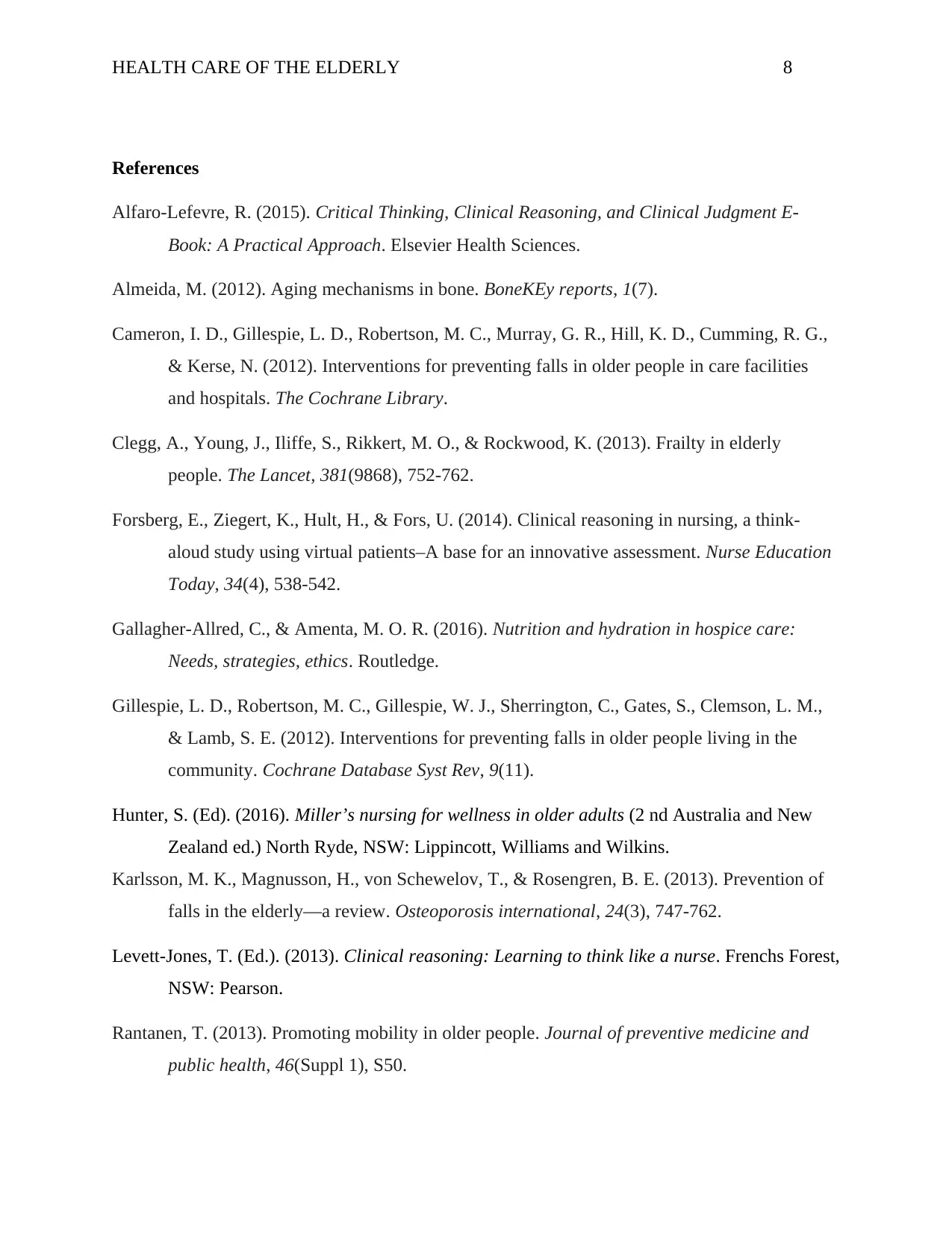
HEALTH CARE OF THE ELDERLY 8
References
Alfaro-Lefevre, R. (2015). Critical Thinking, Clinical Reasoning, and Clinical Judgment E-
Book: A Practical Approach. Elsevier Health Sciences.
Almeida, M. (2012). Aging mechanisms in bone. BoneKEy reports, 1(7).
Cameron, I. D., Gillespie, L. D., Robertson, M. C., Murray, G. R., Hill, K. D., Cumming, R. G.,
& Kerse, N. (2012). Interventions for preventing falls in older people in care facilities
and hospitals. The Cochrane Library.
Clegg, A., Young, J., Iliffe, S., Rikkert, M. O., & Rockwood, K. (2013). Frailty in elderly
people. The Lancet, 381(9868), 752-762.
Forsberg, E., Ziegert, K., Hult, H., & Fors, U. (2014). Clinical reasoning in nursing, a think-
aloud study using virtual patients–A base for an innovative assessment. Nurse Education
Today, 34(4), 538-542.
Gallagher-Allred, C., & Amenta, M. O. R. (2016). Nutrition and hydration in hospice care:
Needs, strategies, ethics. Routledge.
Gillespie, L. D., Robertson, M. C., Gillespie, W. J., Sherrington, C., Gates, S., Clemson, L. M.,
& Lamb, S. E. (2012). Interventions for preventing falls in older people living in the
community. Cochrane Database Syst Rev, 9(11).
Hunter, S. (Ed). (2016). Miller’s nursing for wellness in older adults (2 nd Australia and New
Zealand ed.) North Ryde, NSW: Lippincott, Williams and Wilkins.
Karlsson, M. K., Magnusson, H., von Schewelov, T., & Rosengren, B. E. (2013). Prevention of
falls in the elderly—a review. Osteoporosis international, 24(3), 747-762.
Levett-Jones, T. (Ed.). (2013). Clinical reasoning: Learning to think like a nurse. Frenchs Forest,
NSW: Pearson.
Rantanen, T. (2013). Promoting mobility in older people. Journal of preventive medicine and
public health, 46(Suppl 1), S50.
References
Alfaro-Lefevre, R. (2015). Critical Thinking, Clinical Reasoning, and Clinical Judgment E-
Book: A Practical Approach. Elsevier Health Sciences.
Almeida, M. (2012). Aging mechanisms in bone. BoneKEy reports, 1(7).
Cameron, I. D., Gillespie, L. D., Robertson, M. C., Murray, G. R., Hill, K. D., Cumming, R. G.,
& Kerse, N. (2012). Interventions for preventing falls in older people in care facilities
and hospitals. The Cochrane Library.
Clegg, A., Young, J., Iliffe, S., Rikkert, M. O., & Rockwood, K. (2013). Frailty in elderly
people. The Lancet, 381(9868), 752-762.
Forsberg, E., Ziegert, K., Hult, H., & Fors, U. (2014). Clinical reasoning in nursing, a think-
aloud study using virtual patients–A base for an innovative assessment. Nurse Education
Today, 34(4), 538-542.
Gallagher-Allred, C., & Amenta, M. O. R. (2016). Nutrition and hydration in hospice care:
Needs, strategies, ethics. Routledge.
Gillespie, L. D., Robertson, M. C., Gillespie, W. J., Sherrington, C., Gates, S., Clemson, L. M.,
& Lamb, S. E. (2012). Interventions for preventing falls in older people living in the
community. Cochrane Database Syst Rev, 9(11).
Hunter, S. (Ed). (2016). Miller’s nursing for wellness in older adults (2 nd Australia and New
Zealand ed.) North Ryde, NSW: Lippincott, Williams and Wilkins.
Karlsson, M. K., Magnusson, H., von Schewelov, T., & Rosengren, B. E. (2013). Prevention of
falls in the elderly—a review. Osteoporosis international, 24(3), 747-762.
Levett-Jones, T. (Ed.). (2013). Clinical reasoning: Learning to think like a nurse. Frenchs Forest,
NSW: Pearson.
Rantanen, T. (2013). Promoting mobility in older people. Journal of preventive medicine and
public health, 46(Suppl 1), S50.

HEALTH CARE OF THE ELDERLY 9
Rickman, C. B., Farsiu, S., Toth, C. A., & Klingeborn, M. (2013). Dry age-related macular
degeneration: mechanisms, therapeutic targets, and imaging. Investigative ophthalmology
& visual science, 54(14), ORSF68-ORSF80.
Satariano, W. A., Guralnik, J. M., Jackson, R. J., Marottoli, R. A., Phelan, E. A., & Prohaska, T.
R. (2012). Mobility and aging: new directions for public health action. American Journal
of Public Health, 102(8), 1508-1515.
World Health Organization. (2015). World report on ageing and health. World Health
Organization.
Rickman, C. B., Farsiu, S., Toth, C. A., & Klingeborn, M. (2013). Dry age-related macular
degeneration: mechanisms, therapeutic targets, and imaging. Investigative ophthalmology
& visual science, 54(14), ORSF68-ORSF80.
Satariano, W. A., Guralnik, J. M., Jackson, R. J., Marottoli, R. A., Phelan, E. A., & Prohaska, T.
R. (2012). Mobility and aging: new directions for public health action. American Journal
of Public Health, 102(8), 1508-1515.
World Health Organization. (2015). World report on ageing and health. World Health
Organization.
⊘ This is a preview!⊘
Do you want full access?
Subscribe today to unlock all pages.

Trusted by 1+ million students worldwide
1 out of 9
Related Documents
Your All-in-One AI-Powered Toolkit for Academic Success.
+13062052269
info@desklib.com
Available 24*7 on WhatsApp / Email
![[object Object]](/_next/static/media/star-bottom.7253800d.svg)
Unlock your academic potential
Copyright © 2020–2025 A2Z Services. All Rights Reserved. Developed and managed by ZUCOL.



